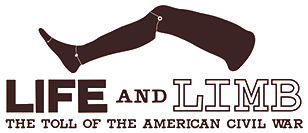
Class 1: Warfare and Wounding: The Human Wheel
Introduction:
This first class introduces, via one primary and three secondary-source readings, the main topics that this module covers: the sometimes contradictory public and professional attitude toward war veterans, mainstream and medical responses to disability, and the implications of Civil War combat injury for both soldiers and society. John Resch explores the symbolic role of the Revolutionary war veteran in the early nineteenth century and uncovers some of the tensions between those who positioned him as a drain on national resources and those who perceived him as patriotic exemplar of the Republic. These tensions were informed by nineteenth-century understandings of dependency, a subject illuminated by two of the leading historians of disability, Sharon Snyder and David Mitchell. Yet some contemporary observers perceived practical possibilities in the Civil War’s impact; physician Oliver Wendell Holmes, for one, contemplated the opportunities offered by prosthetics in the reconstruction of both the individual and the national body; this perspective is explored in David D. Yuan’s analysis of Holmes’s 1863 essay.
Readings:
Primary:
Holmes, Oliver Wendell. “The Human Wheel, Its Spokes and Felloes.” The Atlantic Monthly 11, no. 67 (May 1863): 567-580. Available online at //memory.loc.gov/ammem/ndlpcoop/moahtml/title/lists/atla_V11I67.html (accessed on 03/01/2011).
Secondary:
Resch, John P. Suffering Soldiers: Revolutionary War Veterans, Moral Sentiment, and Political Culture in the Early Republic. Amherst: University of Massachusetts Press, 1999, Chap. 3, Notes for Chap. 3.
Snyder, Sharon L. and David T. Mitchell, Cultural Locations of Disability. Chicago and London: The University of Chicago Press, 2006, Chap. 1.
Yuan, David D. “Disfigurement and Reconstruction in Oliver Wendell Holmes’s “The Human Wheel, Its Spokes and Felloes.”” In The Body and Physical Difference: Discourses of Disability. Edited by David T. Mitchell and Sharon L. Snyder. Ann Arbor: The University of Michigan Press, 1997, 70-88.
Discussion Questions:
- How did early-mid nineteenth-century society respond to war veterans? To what extent did revolutionary precedent inform attitudes toward Civil War soldiers?
- What was the significance of the relationship between prosthetic technology (consider the images presented in Honorable Scars) and modernity, as Oliver Wendell Holmes’s described it, for contemporary responses to the war wounded?
- In what ways might wounded or disabled veterans challenge contemporary ideas about disability and dependency?


